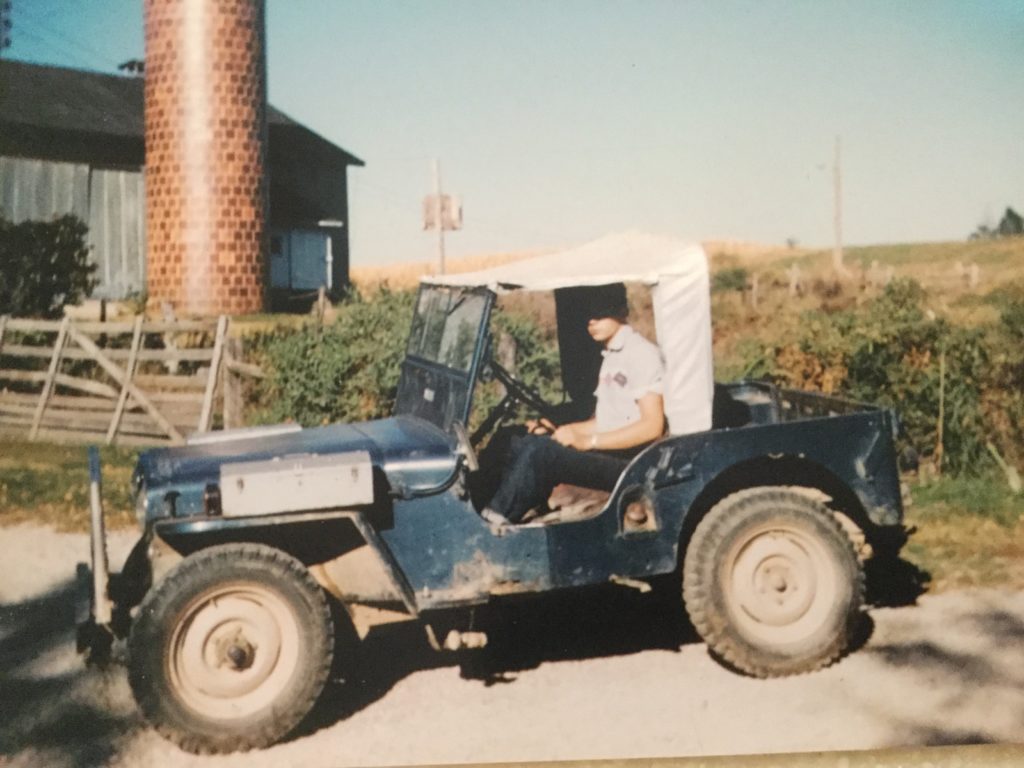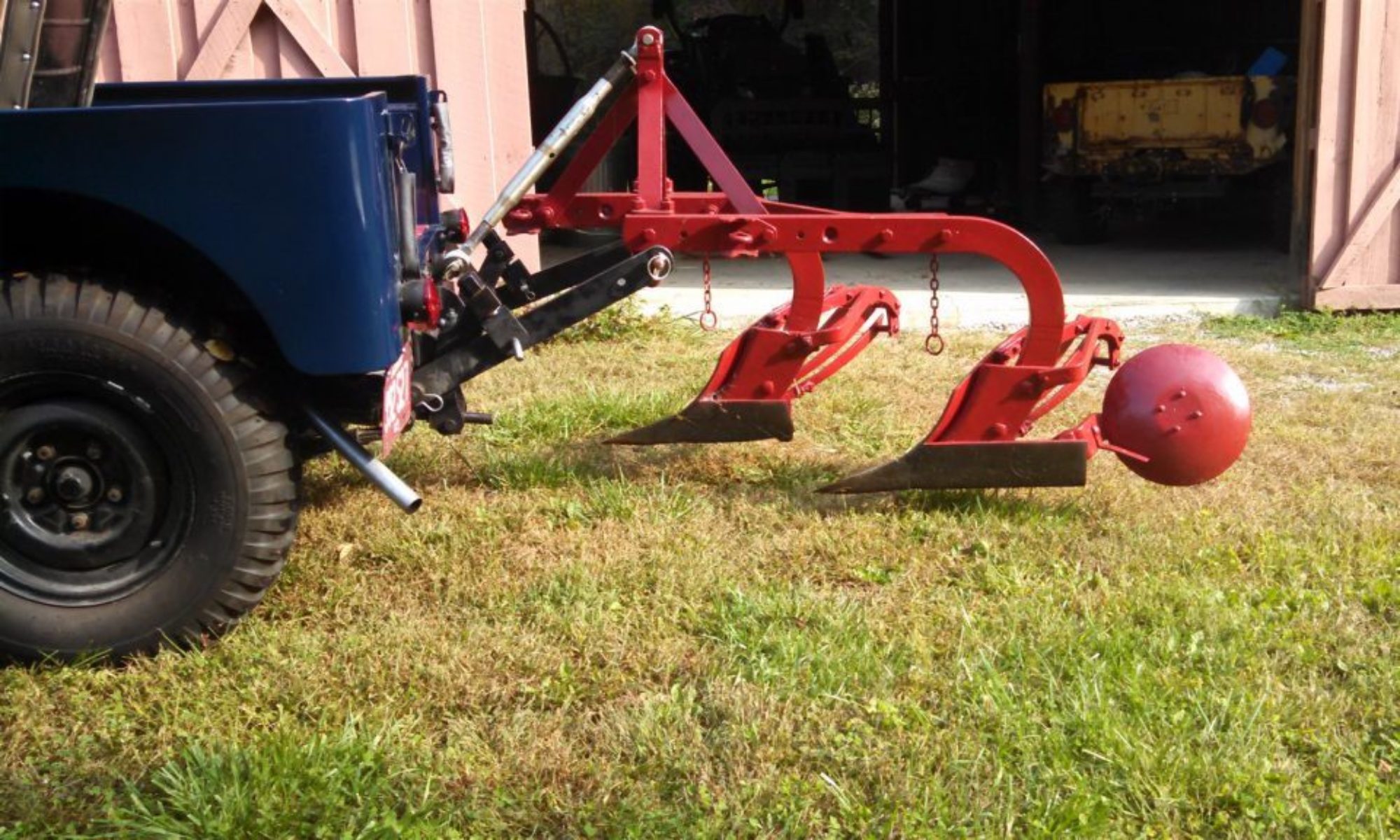We meet one of John’s Farm Jeeps before we meet John. It wasn’t at a Jeep show or an antique equipment show, but at an art museum. You can read the museum story here. John was able to supply the very rare and elusive “non-leaking Willys Jeep” that was needed to be part of the indoor gallery display. John says the “non-leaking” part was achieved through magic.
The first time we were able to meet John in person, Barry was admiring the Newgren “Farm Tested” decal on a lift. Shortly thereafter, a set of decals appeared in the mail. A typical act from a man who enjoys sharing his knowledge and love of Jeeps.
John’s many Jeeps are works of art and he shares them very year at the Willys Jeep Rally. John and his wife Phyllis open their farm and allow visitor to see real working Jeeps. There are numerous videos of the demo online and John’s Jeeps are featured on a number of sites. Good examples are here and here.
We have been lucky enough to hear some of John’s and Phyllis’ Jeep stories and look forward to sharing them here.
Jeep Tales and Trails
by John Ittel

I guess you could say that farming was in my blood after being raised on my grandparent’s farm. I lived there along with my mom and dad, both grandparents and Aunt Edna. Grandpa was getting older and had difficulty doing the usual farm chores. Dad worked in town, mom looked after me and did most of the housework. The farm was rented to my uncle, but an older, fun-loving cousin was the one who planted the corn and soybeans. Whenever he came to do the field work during the summer I was riding on the tractor with him.
World War II was over, and everyone was excited about what the future had in store. Farming was no different. New equipment, new model tractors, livestock care and improved farming practices were in full swing. In order to keep abreast of the latest developments most farm homes received the latest farm publications arriving monthly in the mail. Our home was well stocked with these publications. When I was six or seven I was drawn to these magazines because of the pictures. I was not a magazine reader, but I sure liked daydreaming while I looked at the shiny new tractors. At some point I began to notice ads for a new vehicle called “JEEP.” The ads showed the jeeps plowing, digging post holes, hauling milk cans and taking the family to town on weekends.
All through grade school and junior high I became more fascinated with some day owning a Willys Jeep. The first week of January, 1956, I celebrated my 16th birthday. Three weeks later I passed the test for my Driver’s License. Dad knew I wanted my first car to be a jeep. I had been leaving hints and showing him pictures from the farm magazines.
Around the first of March Dad said we were going for a ride. Twenty minutes later Dad made a sharp turn into a used car lot. In the front row, in all its glory, sat a blue jeep. After some negotiating with the dealer we owned a 1947 CJ2A. My dream became a reality. Just a plain old jeep with a heater, a power take off and a half canvass top. Perfect!
Arriving home I promptly put the jeep in 4WD and headed for the pasture. It had rained the day before, so the ground was very soft. After about fifty feet the jeep started to bog down. Looking back I saw two big ruts left by the Willys. I looked around, thinking dad or grandpa would be upset about tearing up the pasture, but I saw no one. I backed out to firm ground and jumped out. Using my feet I stomped the ruts closed. My dream was shaken when I realized that maybe, just maybe, a jeep could get STUCK.
#2
Spring turned to summer, and I landed a job on our neighbor’s thousand acre hog and dairy farm. Our neighbor, Fred, had two sons, Tom, Phil. They were a couple of years younger than I was. I drove the jeep to work each day, and it soon became a valuable, unpaid farm hand.
The farm was a busy place during the summer and fall. Baling hay, chopping silage and harvesting corn kept us busy. After a day of baling hay we were hot and tired, but we preferred that to loading, hauling and spreading manure.
The little jeep participated in all of these activities. It could pull a wagon with the ease of a draft horse, and after adding a large pipe grill to the front and tire chains on all four wheels, it could further help a tractor by pushing loaded wagons of corn out of the field. And back to the manure – with the PTO engaged, this little wonder could pull the manure spreader, making short work of that which would enrich the soil.
The fall of ’56 was a very wet fall. When I drove the two miles home, after a day of pushing wagons, I left a trail of mud that could be seen the next day on the road. To my knowledge, there were no complaints about the mud on the road, but Mom sometimes fussed about the mud in the driveway.
No one could ever say that the Willys didn’t earn its keep. It was much faster than a tractor in reaching some fields a mile or more from the farm stead. Plus, it was fun for three young guys to hop in and take off. There were times when we got into a squabble over whose turn it was to drive. Regardless, Tom, Phil and I became good friends, and we still are to this day.
#3
In the summer time, once or twice a month, Tom, Phil and I would go camping in their woods. We would run a wire between two trees and drape a tarp over it for our tent. Of course, the jeep carried the supplies. On one of our camping trips we invited two other friends: twins – Fred and Frank, to camp with us. Fred and Frank were a little younger than I was, and they could be quite ornery at times. After a sleepless night, because of their antics and horsing around, Tom, Phil and I decided to get even. The twins slept through breakfast, but breakfast for the three of us was bacon and eggs, (eggs fried in bacon grease). After eating, we promptly pulled down the tarp and proceeded to wrap Fred and Frank in it. The rolled tarp ended up with two heads sticking out of one end and four feet out of the other. We loaded the jeep with the camping equipment, threw Fred and Frank crossways in the back and proceeded to drive through a blackberry patch. By the time we arrived home their socks were missing, and their feet were sporting a few scratches. After getting Fred and Frank unrolled they thought it was the greatest gag ever. We never camped with them again. They went on to become a doctor and a lawyer.
I drove the jeep through the fall and into winter playing in the snow, pulling out a few stuck cars and generally having a great time. By the spring of ’57 I suddenly realized that it was difficult to get a date with a girl while driving a jeep with a half canvas top and not much of a heater. I traded the jeep for a ’51 Ford with overdrive.
I didn’t realize it at the time, but years later, just as I came to regret having walked away from my Black Phantom Schwinn Bike, I would come to regret having given up my first jeep.
#4
Years have a way of quickly coming and going, and before you know it those care free days of youth are distant, happy memories. With a full time job, marriage and a young family, a jeep was not at the forefront of interests and activities, but from time to time, in between restoring antique tractors, I bought and sold 2-3 jeeps. But then, skipping ahead to about 1985, I saw an ad in Hemmings Magazine for a 1946 CJ2A Farm Jeep. It had a front weight, PTO, Monroe Lift, dual rear wheels and a Bantam trailer. I didn’t realize it at the time, but this was the start of my “Farm Jeep Collection.”

In 1991, an uncle passed away. He was a farmer, and on his farm was a 1963 CJ5 jeep. He used the jeep mainly to check his large herd of cattle. After his passing, his wife called and asked if I would be interested in buying the jeep. At that time it had only 5100 miles on the odometer. All four corners were banged up from running into stumps and cows. I brought it home and started a five year rebuild. Other than being banged up, the jeep was like new with no rust. Today it shows 7000 miles.
Having a farm since 1972 and working full time for Cincinnati Bell, I didn’t have a lot of extra time for restoration work, but in 1990, after thirty years with the phone company, I retired, and more time became available to devote to the multi-talented jeep.
I am often asked, “How do you find all the bits and pieces that make up a farm jeep?” My answer/advice/suggestion is to take your jeep to an antique tractor show and listen to the folks who stop and look. The conversation will go something like this. “When I was a kid Dad had a jeep, or a neighbor had one, or, I have this old hitch. I think it used to go on a jeep. (It turned out to be a Stratton for $75.00.) Someone else will say, “I have an old jeep I would like to sell. (53 CJ3B, 64 CJ5, 56 CJ5 Trencher) One time a guy walked up to my display carrying a fiber PTO pulley. He asked, “Got any use for this?” Ten bucks later it was mine.
About 2005 my son took over the management of the farm giving me more time to play with jeeps. I don’t recall ever asking anyone if they wanted to sell their jeep. The jeeps always seemed to find me.
So here I am in 2019, greatly blessed with a wonderful, understanding wife, four kids, a gaggle of grands and greats and a semi-circle of colorful old farm jeeps.
I didn’t do it for fame or fortune. I just like old jeeps, and enjoy sharing them and their story with anyone who cares to listen.


